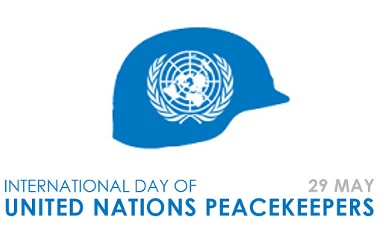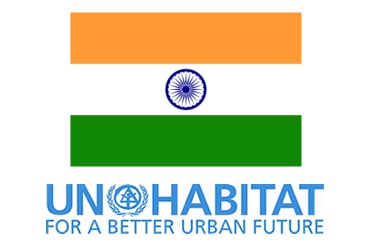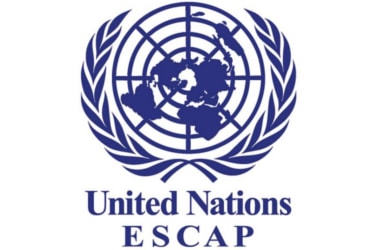UNO - Current Affairs for May, 2017
UNO Current Affairs for May, 2017
Month wise coverage of UNO Current Affairs helps you improve your general knowledge and prepare for all competitive exams like IBPS, Bank PO, SBI PO, RRB, RBI, LIC, Specialist Officer, Clerk, SSC, UPSC, Railway etc. This section is updated daily with the most important events.Preparing UNO Current Affairs May, 2017
1. Read the most important UNO Current affairs and facts here. 2. Take practice test of our UNO MCQ and Objective type questions. 3. Clear any quiz, GK, job interview or competitive exam on current affairs.
- Month & Year
▼ International UN Peacekeper's Day: 29th May [05-30-17]
 International UN Peacekeeper's Day is celebrated world over on 29 May to honour the fallen peacekeepers and to pay tribute to those who served or are still serving in UN peacekeeping missions. International UN Peacekeeper's Day is celebrated world over on 29 May to honour the fallen peacekeepers and to pay tribute to those who served or are still serving in UN peacekeeping missions.
The theme for the 2017 International Day of UN Peacekeepers is “Investing in Peace Around the World”.
In 2016, 117 peacekeepers laid their life in peacekeeping missions which includes two from India. The two fallen peacekeepers from India were Rifleman Brijesh Thapa who served with the United Nations Organization Stabilisation Mission in the Democratic Republic of the Congo (MONUSCO) and Sepoy Ravi Kumar who was deployed with the United Nations Interim Force in Lebanon (UNIFIL) this year.
A two minutes silence was observed to pay homage to the fallen peacekeepers.
India is the largest cumulative troop contributor, having provided almost 200,000 troops in nearly 50 of the 71 peacekeeping missions mandated over the past six decades, including 13 of the current 16 missions.
The event saw participation by diplomatic community, officers from ministries, veteran peacekeepers, UN Country Teams, students from prominent universities and Indian Army contingents earmarked for UN deployment which was supported by UN Information Centre in India (UNIC).
To mark the occasion, Centre for Land Warfare Studies (CLAWS) and Centre for United Nations Peacekeeping (CUNPK) along with United Nations Resident Coordinator’s Office organised a joint seminar on “21st Century Roadmap for Conflict Resolution by the United Nations”.
|
▼ India elected UN Habitat President [05-9-17]
 India has been unanimously elected as the President of the UN-Habitat. UN-Habitat, an organ of the United Nations’ Organisation (UNO) reports to the United Nations General Assembly. India has been unanimously elected as the President of the UN-Habitat. UN-Habitat, an organ of the United Nations’ Organisation (UNO) reports to the United Nations General Assembly.
UN-Habitat promotes socially and environmentally sustainable human settlements across the world. India has been elected as the President of UN-Habitat after a gap of 10 years.
This is only the third time that India has been elected as the President of UN-Habitat after 2007 and 1988. The UN-Habitat was established in 1978.
The Governing Council of UN-Habitat is an inter-governmental policy making and decision making body that aims to promote integral and comprehensive approach to human settlements, assist the countries and regions in addressing human settlement problems and strengthen cooperation among countries over the issue of human settlement.
Minister Venkaaih Naidu will chair the 26th Meeting of 58 member Governing Council of UN-Habitat in Nairobi, Kenya.
The theme of the meeting is “Opportunities for effective implementation of the New Urban Agenda”
He will also chair the Bureau Meeting of the Asia-Pacific Ministers’ Conference on Housing and Urban Development in Nairobi.
The New Urban Agenda which was adopted by the world community at Quito, Ecuador would focus on inclusive, sustainable and adequate housing for a better future and sustainable urbanization and integrated human settlements.
UN-Habitat: Know More
- UN-Habitat, also known as United Nations Human Settlements Program is a UN agency responsible for sustainable urban development and human settlements.
- It was established in 1978 and has its headquarters in the UN Office at Nairobi, Kenya.
- It is mandated by the United Nations General Assembly to promote socially and environmentally sustainable towns and cities with the goal of providing adequate shelter for all.
- It is also a member of UNDP. UN-Habitat works in more than 70 countries in five continents focusing on seven areas:
- Urban Legislation, Land and Governance; - Urban Planning and Design; - Urban Economy; - Urban Basic Services; - Housing and Slum Upgrading; - Risk Reduction and Rehabilitation; - Urban Research and Capacity Development.
|
▼ India to clock 7.1% growth this fiscal: UNESCAP [05-3-17]
 India is expected to clock 7.1 per cent growth this year before edging up to 7.5 per cent in 2018, according to a UN report. India is expected to clock 7.1 per cent growth this year before edging up to 7.5 per cent in 2018, according to a UN report.
The report has warned that the country faces heightened risks related to the concentration of bad loans in the public sector banks.
The UN Economic and Social Commission for Asia and the Pacific (ESCAP) in its annual flagship report 'The Economic and Social Survey of Asia and the Pacific 2017' indicated that the economic growth for India is projected to be stable before edging up.
This is underpinned by higher private and public consumption and increased infrastructure spending.
Growth in India is forecast at 7.1 per cent this year as re-monetisation restores consumption, and infrastructure spending increases.
Inflation is projected to reach 5.3-5.5 per cent in 2017 and 2018, which is somewhat above the official target of 4.5-5 per cent.
The report, however, noted that a key downside risk for India was heightened financial sector risks related to the concentration of bad loans in public sector banks.
The gross non-performing assets ratio in public sector banks reached almost 12 per cent in 2016, which points to the need for bank recapitalisation.
Noting the impact of demonetisation, the report said the unexpected withdrawal of the two largest denomination currency notes in November 2016 and their subsequent replacement with new currency weighed down economic conditions in late 2016 and early 2017.
The resulting liquidity crunch led to delays in the payment of wages and purchase of inputs in the industrial sector.
While the impact of demonetisation on the economy is expected to be transient, a slower-than-expected recovery would particularly diminish the outlook for cash-intensive sectors and supply chains for agricultural products.
The recent budget called for various measures that seek to mitigate the large temporary adverse shocks on income and wealth, such as expanding a low-cost housing scheme and providing more relief to the agricultural sector and credit support for small enterprises.
Notwithstanding its short-term disruptions, the report said one of the medium-term benefits of demonetisation was to help expand banking sector liquidity.
The country's medium-term economic development will also benefit from recent reforms that are aimed at easing domestic supply bottlenecks, such as the implementation of the goods and services tax, amendment of a bankruptcy law and opening up of the pharmaceuticals, defence and civil aviation sectors.
The rate of India's economic growth moderated to 7.1 per cent in 2016 from 7.6 per cent in 2015, with the manufacturing sector more sluggish in 2016 relative to 2015 owing to weaker domestic demand, rising input costs and subdued bank credit.
Fixed investment continued to contract as stressed corporate balance sheets suppressed firms' appetite for additional spending, the report said.
Overall, the still rapid output growth in 2016 benefited from a modest recovery in agriculture due to an improved monsoon season and robust growth in public administration following public sector salary increases.
Despite the overall fiscal tightening, capital expenditure under the budget for fiscal year 2017/18 is about 25 per cent higher than that in the preceding budget.
Outlook for 2017
- The report highlighted that despite a broadly positive economic outlook for 2017, Asia-Pacific economies are vulnerable to rising global uncertainty and trade protectionism.
- The region's developing economies are projected to grow at 5 per cent and 5.1 per cent in 2017 and 2018 up from 4.9 per cent last year.
- Economic conditions are broadly stable in China and higher value-added sectors are gradually replacing excess capacity sectors as drivers of output and employment, the report said.
- The continued softening of economic growth in China, projected at 6.5 per cent in 2017 against 6.7 per cent in 2016, reflects ongoing deleveraging and restructuring efforts to boost output in the medium term, it said.
- The projected moderate Asia-Pacific economic growth faces risks from rising protectionism and global uncertainty, it added.
- The report estimates that a steeper-than-anticipated increase in these factors could reduce average regional growth in 2017 by up to 1.2 percentage points.
|